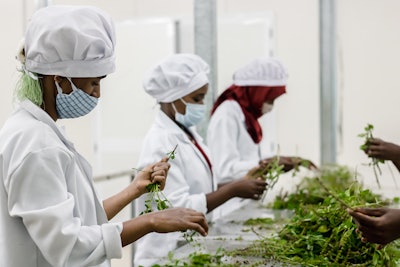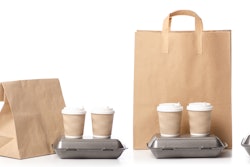
Maintaining a sustainable food chain both upstream and down comes with a host of challenges and opportunities. On one hand, doing so protects people, product and plant, reduces waste, encourages a green economy and ensures the freshest of foods are transported in the safest, most efficient manner possible. Plus, it’s just good business practice.
On the other hand though, an aging infrastructure, a rise in grocery e-commerce and an influx in globalized sourcing continue to stress today’s cold chains.
So, how can companies continue to keep sustainability top of mind amid a global pandemic and continuous supply chain disruptions?
In Food Logistics’ June 2021 issue, editor-in-chief Marina Mayer talks with several industry experts about why sustainable food chains matter and how companies can obtain the supply chain visibility needed to effectively maintain a sustainable food chain.
Here’s an interview with Michele Bruni, chief commercial officer, InspiraFarms, with excerpts publishing in Food Logistics’ June 2021 issue. [CLICK HERE to read the article in full].
Food Logistics: From your vantage point, what are some of the main sustainability-focused challenges today’s cold food chains face?
Michele Bruni: The key point is the lack of a global vision. While an increasing fraction of fresh produce is being sourced globally, many regions in the world have an almost total absence of cold chain or rely on obsolete technologies, resulting in short shelf life, preventing access to high-value markets and generating high rejection rates.
This is preventing producers, consumers and supply chains in general to benefit and are generating massive amounts of greenhouse gas emissions, while proper cooling treatment at source and well managed cold chain can prevent most of this financial and environmental inefficiencies, allowing everyone to capture more value along the chain and consumers to enjoy higher quality food, potentially at a lower price.
The thinness of cold chains is particularly challenging in Africa, while in Europe over 97% of fresh produce goes through cold chain, in Africa we are not even at 4%, resulting in producers capturing, on average, less than half of the global average value per kg.
Let’s think for a second in terms of emissions. Few kg of tomatoes rotting in a pile emit as much 1 kg of diesel used in a genset. Reducing losses and rejections and increasing shelf life is fundamental to reduce the carbon footprint of the units that get actually sold to consumers.
Food Logistics: To piggy-back on this, what are some of the solutions, efforts or initiatives in place to promote sustainable food chains and mitigate waste, etc.?
Bruni: There is momentum around cold chain investment in fresh fruit and vegetables, especially in Africa. The cold chain in Africa requires investment and technology to move faster in that direction: 1) decarbonization requires the integration of renewable energy systems and energy-efficient cooling systems; 2) decentralization through the proliferation of smaller, independent ,but interconnected cold chain facilities along the supply chain starting at production points and 3) digitalization or the integration of Internet of Things (IoT) systems for better management of the independent cooling and energy systems.
A big part of the solution lies in pre-cooling as quickly as possible while minimizing dehydration and other damages to the fruit and vegetables, and ensuring, with data and energy solutions, that can be done on- or near-farm. The other fundamental piece are supply chain partnerships, sustainability, like quality, is as good as the weakest link, so technology providers, third-party logistics (3PL) providers, farmers, exporters and off-takers have to work together through data, to achieve financial and environmental sustainability targets.
InspiraFarms designs and delivers turn-key modular cold rooms and packing houses, cooling and energy solutions for the fresh produce and a fully integrated digital system to monitor and control the process. We range from few tons per day of high-value crops to 2,000-plus tons, designed to respond the need of agribusinesses. InspiraFarms has chosen to invest a lot on high-value crops such as berries and avocados on which we are generating fantastic results for our clients, while covering a crop-mix of 10-12 crops.
Managing pre-cooling is for us the fundamental step to generate sustainability and financial returns. It is essential to gain as much shelf-life and quality possible, key to reduce losses and rejections, and to reduce the energy use per kg throughout the cold chain, and we can demonstrate the impact through our IoT and remote sensing system, tracking fruit and vegetable cooling and storage conditions, energy data and machinery performances.
Our solutions can be coupled with hybrid solar systems, allowing to perform non-stop clean and sustainable operations in contexts with unstable grids.
Food Logistics: Sustainability still matters, even in a global pandemic. Why is this? (Think ESG efforts, renewable energy/packaging, modernization, automation and more).
Bruni: COVID-19 has exposed how fragile are our current food systems and has put an eye on how we produce foods. As an example, the global fresh fruit and vegetable trade was specially affected by the disruption of logistics, while being highly requested from consumers for their health benefits. A great part of the fresh produce we consume is coming from developing countries, shipped by air or sea freight, which has had an important slowdown during the pandemic, as many passenger flights are cancelled, limiting the airfreight capacity to cargo flights, with increased (in some cases doubled) tariffs.
Global trade networks and supply chains are key to the well-being of communities worldwide as they ensure the reliable distribution of vital resources like food. Due to the time and temperature-sensitive nature of many of these goods, quick and efficient pre-cooling and cold chain plays a significant role in ensuring that as much of the harvested product as possible reaches consumers.
The limited penetration of pre-cooling and the reduced availability of cold storage on- or near-farm increased the negative impacts of logistics disruptions. Many agribusinesses, especially those in Africa, bared important losses as there is not enough cold storage capacity available along the supply chain to buffer the disruptions.
Also, most growers, small and large, and also cold storage operators don’t realize that they need to pre-cool before putting the produce into a cold storage, in order to get the best results and to reduce the energy use in the cold storage. Most growers assume that pre-cooling is costly and will not provide any economic gain, while it is the opposite. The extension of shelf life through pre-cooling provides more flexibility on management and logistics of fresh produce, such as baring time lags and the possibility of integrating sea freight as a logistics option that is less costly and more reliable that airfreight.
Food Logistics: How does the Biden Administration’s Climate Change Action Plan and re-joining of the Paris Agreement impact the current and future status of sustainable food chains?
Bruni: It is fundamental for the global leadership that the U.S. administration can play to push for a low-carbon economy and with clear carbon reduction targets, food supply chains can be major contributors to emission reductions that emerge out of annual carbon dioxide captured and methane emitted. Alignment with investment and green accounting has the ability to support a much faster shift towards a new way of approaching values generated in food chains.
Food Logistics: What should companies in the cold food and beverage space do to achieve sustainable food chains? Where do they start if they haven’t done so already?
Bruni: The biggest challenge for building sustainable food supply chains is building the linkage and dialogue among the different key members of the supply chain, for instance between farmers and their buyers and customers. A transparent and data-based integration along supply chains can really support in figuring out what are the issues affecting the sustainability and how this can be resolved with a holistic view of the supply chain.
Avoid methane emissions, leveraging on cooling and food processing and start addressing the energy mix powering food supply chains, as well as bringing more funding towards low carbon food, such as fresh fruit and vegetables, compared to feed and livestock.
Food Logistics: What kinds of technologies/solutions (i.e., Internet of Things, automation, etc.) is your company investing in and why?
Bruni: InspiraFarms is becoming the leading provider of cooling and packhouse solutions for high-value fresh produce across Africa. We have invested heavily on two key aspects -- knowledge on fruit and vegetables to get to the best, while affordable solution for pre-cooling to maximize customers’ returns and IoT and data solution to enable present control of product cooling, energy efficiency and machinery performance and to enable future supply chain integration through data. Last, but not least, on how to bring to our customers tailored asset finance to ease their cash flow while investing in technologies fundamental to play in the global supply chain.
Food Logistics: What does the future of sustainable food chains look like? Any risks/rewards?
Bruni: Businesses and supply chains that are investing in sustainable solutions will be more resilient to face shocks and uncertainty, whether they are generated by COVID-19, climate change or the closure of the Suez Canal. Hopefully in a close enough future, we will see as well consolidated higher prices to reward the ones investing on sustainable food chains.
Food Logistics: What are some things not addressed above that may be pertinent to our readers?
Bruni: Well, a message of hope, we have been growing despite COVID and we were told many times in the past that investing so much on efficiency, compliance and sustainability in Africa was not a good idea. The market is telling a different story and we see many other companies on different segments of the food chain making similar choices and growing while challenging the status quo. Achieving sustainability and financial targets is possible in Africa and beyond.















